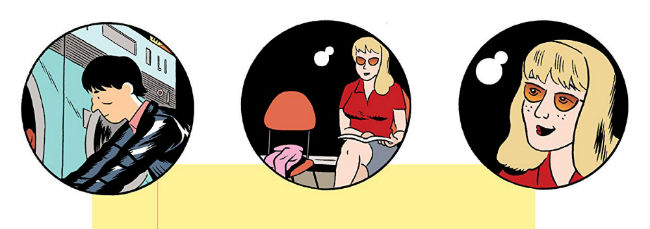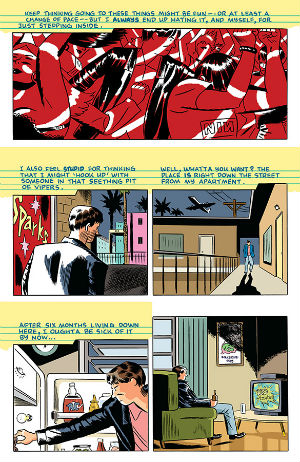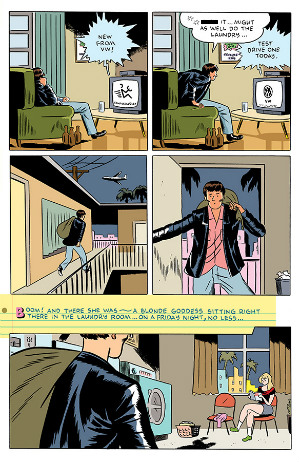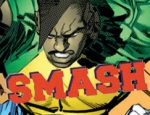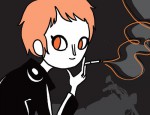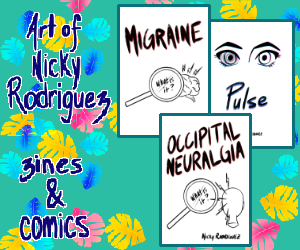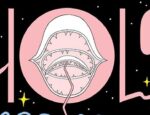The classic pulp detective story and the self-loathing alternative comic are two genres that, on paper, couldn’t be more different. Nonetheless, they make for strange yet surprisingly simpatico bedfellows in Dry County, Rich Tommaso’s new creator-owned series from Image. Protagonist Lou Rossi’s chance encounter with a “blonde bombshell” appears to put him on a path familiar from hardboiled crime fiction, but his first-person narration is less Chandler, more early Optic Nerve.
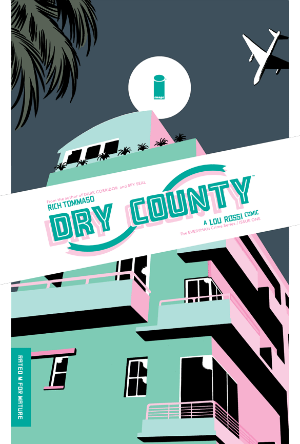 Appearing in narration boxes styled as scribbled notes on yellow legal pads, Rossi’s internal monologue recalls the misanthropic, self-loathing heyday of Eightball and Peter Bagge. His “mind [is] buzzing and swirling in a cesspool of utter frustration”. He despises his creatively-unfulfilling job as a gag cartoonist for the Miami Herald. He is resentful at the easy intimacy of those around him, the “nest of vipers” at the club down the road from his apartment, but nonetheless fantasises going home with one of them. We are party to his innermost thoughts and his humiliations, such as a violent vomiting fit after an all-night drinking session with John, his only buddy in town (who he also kind of hates).
Appearing in narration boxes styled as scribbled notes on yellow legal pads, Rossi’s internal monologue recalls the misanthropic, self-loathing heyday of Eightball and Peter Bagge. His “mind [is] buzzing and swirling in a cesspool of utter frustration”. He despises his creatively-unfulfilling job as a gag cartoonist for the Miami Herald. He is resentful at the easy intimacy of those around him, the “nest of vipers” at the club down the road from his apartment, but nonetheless fantasises going home with one of them. We are party to his innermost thoughts and his humiliations, such as a violent vomiting fit after an all-night drinking session with John, his only buddy in town (who he also kind of hates).
Lou is shaken out of this shiftless slacker melancholy when he meets Janet, the aforementioned blonde, doing laundry in his building. When he somehow manages to land a date with her, however, he more or less sabotages his chance through his introversion and low self-esteem. Then the pulp starts to creep in around the self-published edges. Janet is looking for a way out of her current unhappy relationship. She only stays with the guy out of obligation, since he helped her escape a previous, abusive boyfriend. Lou gets to play hero of the beach when he hears Janet and the current beau arguing on the roof of his apartment block, but you get the sense he doesn’t know what he’s getting himself into.
The two genres are not so easy to separate in Dry County. They run parallel to each other, and that’s a large part of the appeal. Tommaso winks knowingly at the tropes of each. One page opens with Lou with his feet up on a desk, contemplating his erstwhile femme fatale’s predicament in a classic Philip Marlowe manner…only for his gumshoe cool to be undercut by his boss walking in and demanding he leave her office. On the alt-comic side of things, he spends a lot of his times looking gloomy and walking around with his hands shoved in his pockets, his mood not matched by the bright Miami Vice palette of his surroundings.
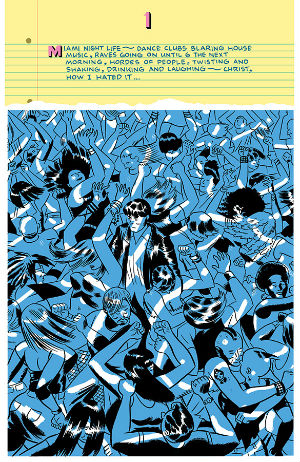 Over the past few years Tommaso has established himself as one of the best (and infuriatingly underrated) genre artists in comics. He previously approached the crime thriller with his anthology series Dark Corridor, which had a similar dynamic of introducing some postmodern humour and comic verve to the genre, bridging the gap between Dick Tracy and the work of Brubaker/Phillips. His explicitly-Hergé-inspired Spy Seal series is an all-ages espionage adventure which rises above mere pastiche thanks to his fantastic cartooning. Meanwhile She-Wolf took familiar horror tropes somewhere far weirder, and far more feverishly surreal, through its offbeat story and Tommaso’s surreal watercolour artwork.
Over the past few years Tommaso has established himself as one of the best (and infuriatingly underrated) genre artists in comics. He previously approached the crime thriller with his anthology series Dark Corridor, which had a similar dynamic of introducing some postmodern humour and comic verve to the genre, bridging the gap between Dick Tracy and the work of Brubaker/Phillips. His explicitly-Hergé-inspired Spy Seal series is an all-ages espionage adventure which rises above mere pastiche thanks to his fantastic cartooning. Meanwhile She-Wolf took familiar horror tropes somewhere far weirder, and far more feverishly surreal, through its offbeat story and Tommaso’s surreal watercolour artwork.
The art of Dry County is recognisably Tommaso, but nonetheless of a different stripe to his past comics. As with the works of the alt-comics canon including Spiegelman, Ware and Clowes, Tommaso has a clear affection for the history of American gag cartooning. Lou’s all-night drinking sessions are shared with his punk friend Robert, whose laughing face in profile resembles a Kings Features character. His appearance is all the more jarring when he tells Lou about an attempted drive-by near his work, and insists that a car full of women who cut him off in traffic “totally wanted to suck [his] cock.” Elsewhere there are page layouts with round insert panels that recall, of all things, Family Circus (there’s a particular neat motif during Lou and Janet’s first meeting, where their faces are shown in close-up in round panels mimicking the door of the washing machines they’re sat in front of).
Pacing and storytelling-wise, though, this first installment places it relatively straight. Which is not to say there aren’t moments of humour and, owing to the Florida setting, it’s a lot more colourful than your standard noir. The issue opens with a splash page of Lou at the aforementioned club, standing alone in a sea of dancing bodies, a striking image rendered with a primary blue tint highlighted by streaks of white strobe. Later, he sits on his balcony, watching the sun go down as he downs a six-pack of beer, the sky and the buildings taking on pastel greens, pinks and blues of Little Havana.
It’s a heady mix of influences and aesthetics which nonetheless coalesce into something more. These seemingly incongruous genres prove to have a surprising amount in common, from the extensive use of of first-person narration, to the protagonist who’s kind of a mess, their shiftless existence shaken up by the arrival of romance, to the low-key misogyny of a story dominated by male characters. It’s just that Marlowe was never as whiny as an author-insert in Hate, and old Adrian Tomine comics relied more on existential weariness or low-level domestic drama to moves the stories towards some sort of conclusion.
You can sort of see the rapidly-escalating series of encounters with the criminal underworld coming, the seemingly happy final image of Lou and Janet embracing against a stormy sky full of ill portent. It remains to be seen if a neurotic, misanthropic alt-comic slacker will prevail against the crooks and thugs his new love appears to be mixed up with, and if the series will continue to utilise all the cliches in the toyboxes of its respective genres without lapsing into one-dimensional parody. With Tommaso at the controls, the odds are in Dry County’s favour.
Rich Tommaso (W/A) • Image Comics, $3.99
Review by Tom Baker





